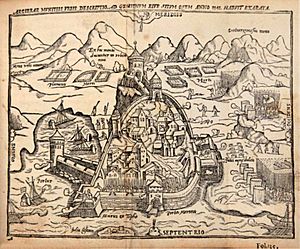Algiers expedition (1541) facts for kids
Quick facts for kids Algiers expedition |
|||||||
|---|---|---|---|---|---|---|---|
| Part of the Ottoman-Habsburg wars | |||||||
 Siege of Algiers in 1541. Engraving of 1555. |
|||||||
|
|||||||
| Belligerents | |||||||
|
|||||||
| Commanders and leaders | |||||||
| Charles V Navy: Andrea Doria Army: Duke of Alba Including: |
|||||||
| Strength | |||||||
| Total of 80 galleys Total of 500 ships 12,000 sailors 24,000 soldiers Including: |
800 Janissary 5,000 Moors |
||||||
| Casualties and losses | |||||||
| 300 officers killed 8,000 or 12,000 killed 150 ships sunk |
200 killed | ||||||
The 1541 Algiers expedition was a big military mission led by Charles V. He was the powerful emperor of the Holy Roman Empire and also the King of Spain. Charles V wanted to attack Algiers, a city in modern-day Algeria. At the time, Algiers was controlled by the Ottoman Empire.
This attack involved both land and sea forces, but it failed. The main reasons for its failure were poor planning and very bad weather.
Why the Expedition Happened
Algiers had been under the control of the Ottoman Empire since 1529. A famous Ottoman admiral named Hayreddin Barbarossa had captured it. In 1535, Barbarossa left Algiers to become the top admiral for the Ottoman Sultan Suleiman the Magnificent.
A man named Hassan Agha took over as governor of Algiers. He had skilled naval commanders working for him, including Dragut and Sālih Reïs. Charles V wanted to get revenge for a recent defeat at Buda. So, he decided to launch a major attack on Algiers.
However, Charles V's plans faced problems early on. A big storm damaged his Spanish and Genoese fleets. This forced him to delay and almost give up the mission.
The Expedition Begins
Charles V started his journey very late in the year, on September 28, 1541. He had been delayed by issues in Germany and Flanders. His huge fleet gathered in the Bay of Palma, in Majorca. It included more than 500 ships and 24,000 soldiers.
The fleet faced tough weather conditions. They finally reached Algiers on October 19. Many important Spanish commanders joined Charles V. This included Hernán Cortés, who had conquered Mexico. However, Cortés was not asked to join the war meetings.
On October 23, the troops began to land. Charles V set up his main camp on a piece of land surrounded by German soldiers. German, Spanish, and Italian troops, along with 150 Knights of Malta, landed. They fought off the Algerine defenders and soon surrounded the city. Only the northern part remained open.
It looked like Algiers would be captured. But the next day, the weather turned terrible. There was heavy rain and strong winds. Many ships lost their anchors, and 15 were destroyed on the shore. Another 33 large ships called carracks sank. Many more ships were scattered by the storm.
As more troops tried to land, the Algerine defenders attacked. They killed many of the newly arrived soldiers. Charles V himself was surrounded. He was only saved by the brave resistance of the Knights of Malta.
Andrea Doria, a naval commander, found a safer harbor for the remaining ships. This was at Cape Matifu, about five miles east of Algiers. He told Charles V to leave his position and join him there. Charles V did so, but it was very difficult.
From Cape Matifu, still battling bad weather, the remaining troops sailed to Bougie. This was a Spanish harbor at the time. Charles V could only finally leave for the open sea on November 23. He even threw his horses and crown overboard to lighten his ship. He left his army behind and sailed home. Charles V finally reached Cartagena, in southeast Spain, on December 3.
The invading forces suffered huge losses. About 150 ships were lost. Many sailors and soldiers died. A Turkish writer said that the Berber tribes killed 12,000 invaders. So many of Charles V's soldiers were captured that there were too many slaves in Algiers. People even said that in 1541, Christians were sold for the price of an onion!
What Happened Next
This disaster greatly weakened the Spanish forces. Hassan Agha, the governor of Algiers, used this chance to attack Mers-el-Kebir. This was the harbor for the Spanish base of Oran. This attack happened in July 1542.
See also
 In Spanish: Jornada de Argel para niños
In Spanish: Jornada de Argel para niños

